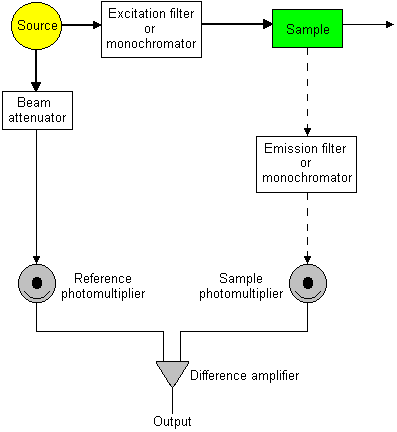


Often, fluorescence spectrometers use double-beam optics to compensate for power fluctuations in the source. The fluorescent emission is measured at right angles to the incident beam. Emitted radiation passes through a second filter or monochromator to isolate the fluorescent peak for measurement. The reference beam passes through an attenuator to reduce its power to that of the fluorescent radiation.
Fluorometers use filters to restrict excitation and emission beam wavelengths.
Spectrofluorometers have two monochromators; one allowing choice of excitation wavelength and the other allowing fluorescence emission spectra to be scanned.
Filter fluorometers often employ a low-pressure mercury vapour lamp. This source produces intense lines at certain wavelengths. One of these lines will usually be suitable for excitation of a fluorescent sample.
Spectrofluorometers, which need a continuous radiation source, are often equipped with a 75-450 W high-pressure xenon arc lamp.
Lasers are sometimes used as excitation sources. A tunable dye laser, using a pulsed nitrogen laser as the primary source can produce monochromatic radiation between 360 and 650 nm. Since the radiation produced is monochromatic, there is no need for an excitation monochromator.
Filters and monochromators
Fluorometers use either interference or absorption filters. Spectrofluorometers
are usually fitted with grating monochromators.
Detectors
Fluorescence signals are usually of low intensity. Photomultiplier tubes
are in common use as detectors. Diode-array detectors are sometimes used.
Instruments for measuring phosphorescence are very similar to those used for fluorescence. However, two additional components are needed:
A mechanism or electronic circuit is required which allows the sample to be irradiated, and then after a time delay, allows measurement of phosphorescent intensity.Since phosphorescence is aided by low temperatures and a viscous medium, the analyte is present as a solute in a solid solvent "glass" in liquid nitrogen. A Dewar flask with quartz windows is often used.
|
|
|

 Biosciences Homepage
Biosciences Homepage
 |